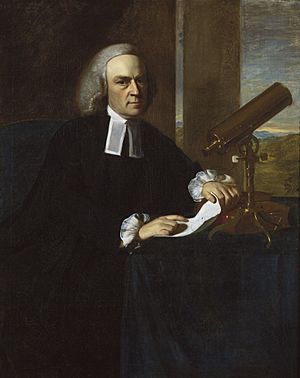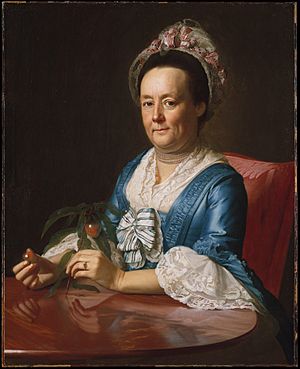John Winthrop (educator) facts for kids
Quick facts for kids
John Winthrop
|
|
|---|---|

Portrait by John Singleton Copley, c. 1773
|
|
| Acting President of Harvard College | |
| In office 1769–1769 |
|
| Preceded by | Edward Holyoke |
| Succeeded by | Samuel Locke |
| In office 1773–1773 |
|
| Preceded by | Samuel Locke |
| Succeeded by | Samuel Langdon |
| Personal details | |
| Born | December 19, 1714 Boston, Province of Massachusetts Bay |
| Died | May 3, 1779 (aged 64) Cambridge, Massachusetts |
| Alma mater | Harvard College |
John Winthrop (born December 19, 1714 – died May 3, 1779) was an important American mathematician, physicist, and astronomer. He held a special teaching position at Harvard College. This position was called the Hollis Professor of Mathematics and Natural Philosophy.
Contents
Early Life and Education
John Winthrop was born in Boston, Massachusetts. His family was famous. His great-great-grandfather, also named John Winthrop, helped start the Massachusetts Bay Colony.
John Winthrop graduated from Harvard College in 1732. He later became a professor there in 1738. He taught mathematics and natural philosophy at Harvard until he passed away.
Scientific Career and Discoveries
Professor Winthrop was one of the most important scientists in America during the 1700s. He had a big impact on science in New England. Famous scientists like Benjamin Franklin and Benjamin Thompson were likely inspired by him.
Winthrop also helped educate John Adams, who later became a U.S. President. He often wrote to the Royal Society in London. This showed that American thinkers were starting to be recognized in Europe. He also joined the American Philosophical Society in 1768.
Explaining Earthquakes
John Winthrop was known for trying to explain the huge Lisbon earthquake of 1755. He believed it was a natural event, not a religious sign. He used math to study earthquakes. Because of this, some people call him the founder of seismology, which is the study of earthquakes.
Observing Planets
Winthrop also studied planets. He watched Mercury pass in front of the Sun in 1740 and 1761. He even traveled to Newfoundland to observe a transit of Venus. The Province of Massachusetts provided a ship for this trip. This was likely the first scientific trip ever sent out by an American state.
It is important to know that in the 1700s, some people in the American colonies owned enslaved people. Records show that John Winthrop owned two enslaved men, named George and Scipio, in 1759 and 1761.
Leadership and Public Service
John Winthrop served as the acting president of Harvard College twice. He was acting president in 1769 and again in 1773. Both times, he was offered the full presidency. However, he turned it down because he felt he was too old.
During the Revolutionary War, Harvard College moved to Concord, Massachusetts. This was from 1775 to 1776. During this time, Winthrop lived in a house that later became famous. It was called The Wayside. This house later belonged to famous writers like Louisa May Alcott and Nathaniel Hawthorne.
Winthrop was also interested in public affairs. He was a judge for several years in Middlesex County. He was also a member of the Governor's Council in 1773–74. He supported the American cause during the Revolution.
Published Works
John Winthrop wrote several books and papers. These include:
- Lecture on Earthquakes (1755)
- Answer to Mr. Prince's Letter on Earthquakes (1756)
- Account of Some Fiery Meteors (1755)
- Two Lectures on the Parallax (1769)
Personal Life

In 1756, John Winthrop married Hannah Fayerweather. She was born in 1727 and passed away in 1790. Hannah had been married before in 1745.
John and Hannah raised Winthrop's son from his first marriage, James Winthrop. James continued his father's work in politics.

